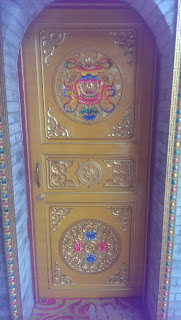As another site visit for my
Chinese philosophy class, I got a group together to go to Guangren Monastery. This
temple is by far the most impactful site I have visited, the atmosphere of the
temple grounds holding weight and depth like an aura. The only Tibetan Buddhist
temple in Shaanxi, the Guangren Monastery lies just inside the northwest corner
of the Xi’an city wall. The temple is gorgeous, managing to be both
ridiculously ostentatious as well as incredibly humbling. The temple is used mostly
by locals, and holds great cultural significance for its place in Xi’an’s
society. This is extremely important, as the great majority of visitors to the
temple are not tourists, but instead locals wishing to pay their respects to a
Buddha or Bodhisattva of their choice. Although the temple is Buddhist, it
portrays several elements of Daoism and Confucianism through symbols and
architecture throughout the monastery, creating an amalgamation of Chinese
philosophies. The Guangren Monastery is a place of worship first, and landmark second,
a beautiful structure with not only cultural and historical significance, but
also strong connections to longstanding Chinese philosophies.
A
waving, fluttering awning precedes the gates of Guangren Monastery, the flags
attached to it whipped and wafted by the wind. Four Tibetan stupas of gleaming
white marble sit on either side of the temple, each representing one of the
Eight Auspicious Symbols, icons that are ubiquitous throughout the Guangren
Monastery. Below each of the stupas is a short description written in three
languages, Tibetan, Manchu, and Chinese. Entering the monastery, the first
thing to catch the eye is an enormous carved stone wall, or Zhao Bi, placed
directly inside the gate. Upon it is carved Buddha and a chained tiger beneath
a peach tree, surrounded by the clouds above, mountains on the right, and the
sea below. Past the Zhao Bi is a small hexagonal pagoda, which contains a stele
with an inscription by Emperor Kangxi during the Qing dynasty. Four inner walls
and four outer walls of the pavilion portray the eight auspicious symbols in
vivid colors. Beyond the pavilion you will pass two octagonal walled pools, on
which are also carved the eight symbols. Soon after is a marvelous hall
dedicated to the Thousand-Hand Buddha, whose statue within glitters and gleams
from heavy gold gilding. Around the back of the hall, two glass-encased vibrant
and colorful paintings, one of the Ha destroying the enemies of Buddhism, and the
other a detailed depiction of the Dharma Wheel lie on the reverse side of the
hall. This courtyard also contains an enormous lamp, referred to as the “Ten
Thousand Year Lamp,” which can be filled with enough kerosene to last days. Moving
onward, you will reach the grandiose Hall of Longevity, containing gilded
statues of different Buddhas and surrounded by rotational sutra barrels, gold
barrels that we watched many of the visitors spin as they walked around the
hall. Passing through this hall, Guangren Monastery then opens up to another
large courtyard. Here, a gargantuan building fills the view, its gold roofs
glimmering, and its colorful and ostentatious design dazzling the eyes. This is
the keeping hall of the monastery, a depository of thousands of Buddhist
scripts. This hall contains a Buddha statue at the forefront, and behind that
statue stands a grandiose, two story tall golden figure whose upper body is
lost among the multicolored rafters. The Guangren Monastery is beautiful and timeless,
the sincerity of its visitors contradicting the skyscrapers just beyond the
temple walls.
There
was definitely something special about this temple. Speakers around the temple project
a live chant originating somewhere within the monastery, and although they are modern
instruments, the speakers manage to create an atmosphere of peace and
spirituality. It is difficult not to feel something as you watch monks walk languidly
stroll through the temple, past kneeling visitors and songs sung in reverence.
Guangren Monastery was an amazing temple to visit, and I am glad I had the
opportunity to experience it.




No comments:
Post a Comment